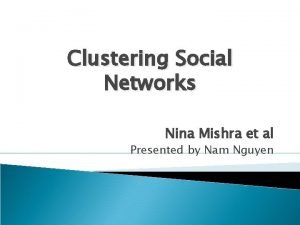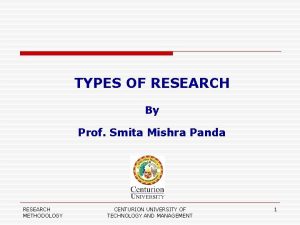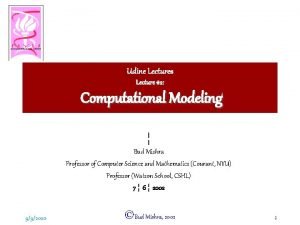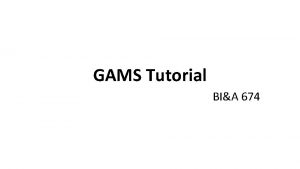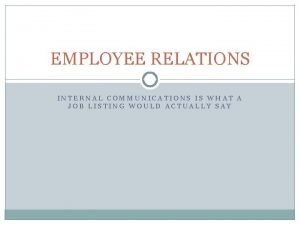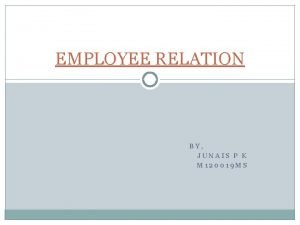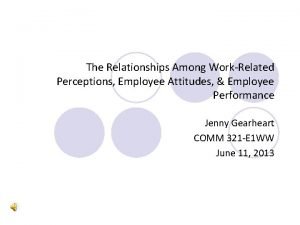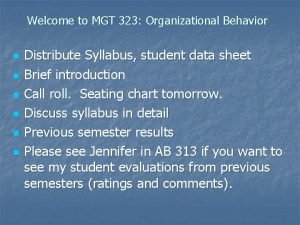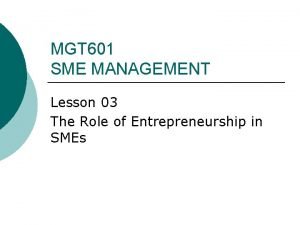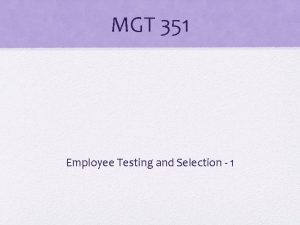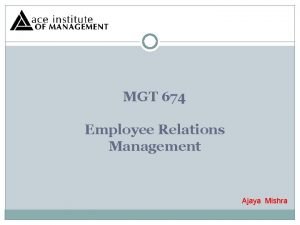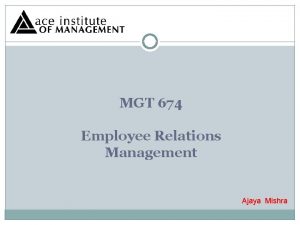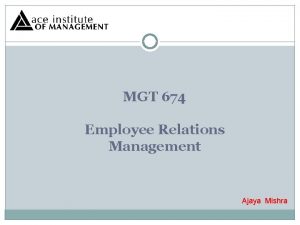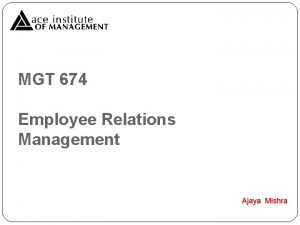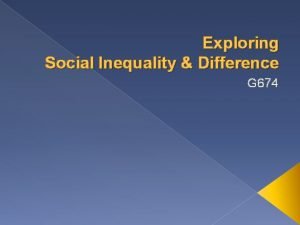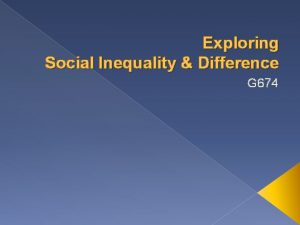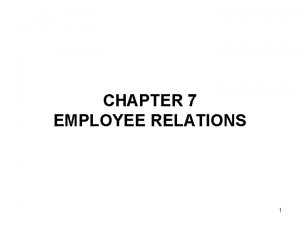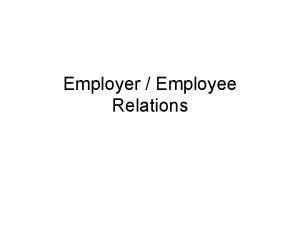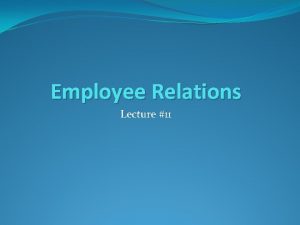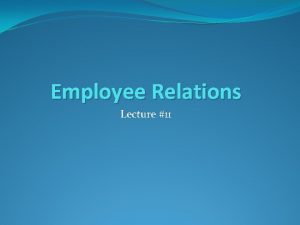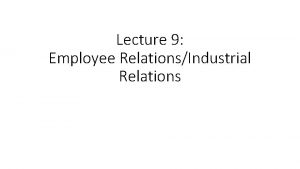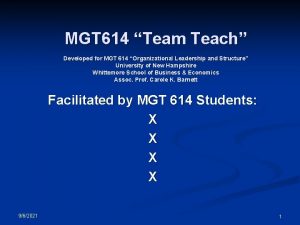MGT 674 Employee Relations Management Ajaya Mishra Employee

























- Slides: 25

MGT 674 Employee Relations Management Ajaya Mishra

Employee Relations Session 4 Culture and It’s Impact on Employee Relations … Unionization and Employment Generations …

Culture … … an integrated pattern of human knowledge, belief, and behavior that depends upon the capacity for symbolic thought and social learning. … the set of shared attitudes, values, goals, and practices that characterizes an institution, organization, or group.

Corporate Culture … “. . . A group or organizational-level of shared beliefs and values that lead to norms and expectations for members of that culture. It is the “glue” that holds an organization together through shared assumptions, beliefs, and processes. In short, it speaks to ‘how things are done here’

Hofstede’s Cultural Dimensions … Power Distance Index (PDI) that is the extent to which the less powerful members of organizations and institutions accept and expect that power is distributed unequally. This represents inequality, but defined from below, not from above. It suggests that a society's level of inequality is endorsed by the followers as much as by the leaders. Individualism (IDV) on the one side versus its opposite, collectivism, that is the degree to which individuals are integrated into groups. On the individualist side societies in which the ties between individuals are loose: everyone is expected to look after him/herself and his/her immediate family. On the collectivist side, societies in which people from birth onwards are integrated into strong, cohesive in-groups, often extended families which continue protecting them in exchange for unquestioning loyalty.

Masculinity (MAS) versus its opposite, femininity, refers to the distribution of roles between the genders which is another fundamental issue for any society. The IBM studies revealed that (a) women's values differ less among societies than men's values; (b) men's values from one country to another contain a dimension from very assertive and competitive and maximally different from women's values on the one side, to modest and caring and similar to women's values on the other. Uncertainty Avoidance Index (UAI) deals with a society's tolerance for uncertainty and ambiguity. It indicates to what extent a culture programs its members to feel either uncomfortable or comfortable in unstructured situations. People in uncertainty avoiding countries are more emotional, and motivated by inner nervous energy. The opposite type, uncertainty accepting cultures, are more tolerant of opinions different from what they are used to. People within these cultures are more phlegmatic and contemplative, and not expected by their environment to express emotions.

Long-Term Orientation (LTO) versus short-term orientation: Values associated with Long Term Orientation are thrift and perseverance; values associated with Short Term Orientation are respect for tradition, fulfilling social obligations, and protecting one's 'face'. Both the positively and the negatively rated values of this dimension are found in the teachings of Confucius, the most influential Chinese philosopher who lived around 500 B. C. ; however, the dimension also applies to countries without a Confucian heritage.

World Average of Hofstede’s Dimensions…

Comparison in USA and India

Comparison Japan and Pakistan

Other Cultural Dimensions … High Performance … a 'high performance culture' exists when everyone in the organization shares the same vision and where they trust and value each other's contribution. Constructive … a constructive culture is defined simplistically as one oriented towards achievement, self-actualization, creativity, participation, valuing people, and one that places a high priority on healthy relationships between people.

Power Based on strength, justice, benevolence. Depends on acceptance of hierarchy and inequality between people as legitimate Can degenerate into intrigue, politics and back-stabbing Structure Provides stability, justice and efficiency. Impersonal, Assumes people are not trusted

Achievement People aligned to the vision / purpose of company Self-supervision, High morale, teamwork, energy. Values larger than profit or growth Can lead to arrogance, elitism, lack of cooperation Support Foster warmth and caring Open and lots of communication helps in greater understanding People are not judgmental about each other Values harmony and avoids confrontation

Some other Clustures of Culture … Bureaucratic Culture Formality, rules, standard operating procedures, hierarchy. Clan Culture Tradition, loyalty, personal commitment, high level of socialization, self management, social influence Entrepreneurial Culture High risk taking, creativity. Market Culture Demanding goals like sales, profitability, market share.

Socialization steps for shaping culture … Role Model to sustain the Culture Rituals, and Stories to reinforce the Culture Adoption of Cultural Values Removal who deviate from culture Reward to sustain the culture Training for developing culture Challenging Early Assignments Careful Selection Removal who do not fit the Culture

Culture and ER Cultural Dimensions Power Distance: High or Low Features Inequality, Bossism, Lack of Open Communication Individualistic / Collective Selfishness Group Cohesion. Masculinity / Femininity Aggression, High PD Caring and Nurturing Uncertainty Avoidance High tolerance / patience Low tolerance / patience Long term / Short term Orientation Respect , tradition/ value Opportunity… Effect on ER

Cultural Dimensions Features Power Strength, justice, acceptability Structure Stability, justice, efficiency Achievement Aligned to vision, self supervisory, team work, high morale. Support Warmth and caring, open communication, values harmony. Effect on ER

Others …. Social values Organization History Personal traits and orientation. Leadership style ……. ……

Characteristics of Nepali Management Culture value of non-assertiveness value of respect for seniors/elderly people value of loyalty, respect for authority & hierarchy value of collectivism value of harmony value of preserving face value of trust and relationship building value of tolerance and respect for differences

UNIONIZATION AND EMPLOYMENT CREATION …

Advantage and Disadvantage … Advantage Disadvantage Increased wage / benefits Labor strikes Job protection Limited Flexibility Collective bargaining Higher production cost Good working condition Low competitive capacity

Factors Affecting Job Creation … Economic Growth Industrial Service Agriculture Business Environment Social, Technical, Political, Legal Availability of Resources Power, Workforce, Raw Materials …

Occupational / Workplace Safety … Occupational health and safety is a cross- disciplinary area concerned with protecting the safety, health and welfare of people engaged in work or employment. The goal of all occupational health and safety programs is to foster a safe work environment

To ensure the safety and health of workers, managers establish a focus on safety that can include elements such as: management leadership and commitment employee engagement accountability safety programs, policies, and plans safety processes, procedures, and practices safety goals and objectives safety inspections for workplace hazards safety program audits hazard identification and control safety committees to promote employee involvement safety education and training safety communications to maintain a high level of awareness on safety

 Employee relations in public relations
Employee relations in public relations Nischal mishra
Nischal mishra Dr anup mishra herbalife
Dr anup mishra herbalife Nina mishra
Nina mishra Smita mishra panda
Smita mishra panda Imnci guidelines for diarrhoea
Imnci guidelines for diarrhoea Bud mishra
Bud mishra Kalanand mishra
Kalanand mishra Kalanand mishra
Kalanand mishra Dipti mishra iiit hyderabad
Dipti mishra iiit hyderabad Kirti mishra
Kirti mishra Dr arvind mishra
Dr arvind mishra Dr padma mishra bhopal
Dr padma mishra bhopal Fdi notation
Fdi notation Akar pangkat 2 dari 674
Akar pangkat 2 dari 674 Am artinya
Am artinya Jika log 3 = 0
Jika log 3 = 0 Gams674
Gams674 Difusion simple
Difusion simple Employee relations communications
Employee relations communications Importance of employee relation
Importance of employee relation Employee attitudes and employee performance
Employee attitudes and employee performance Mgt 323
Mgt 323 Meaning of management accounting
Meaning of management accounting Mgt 601
Mgt 601 Mgt 351 nsu course outline
Mgt 351 nsu course outline



